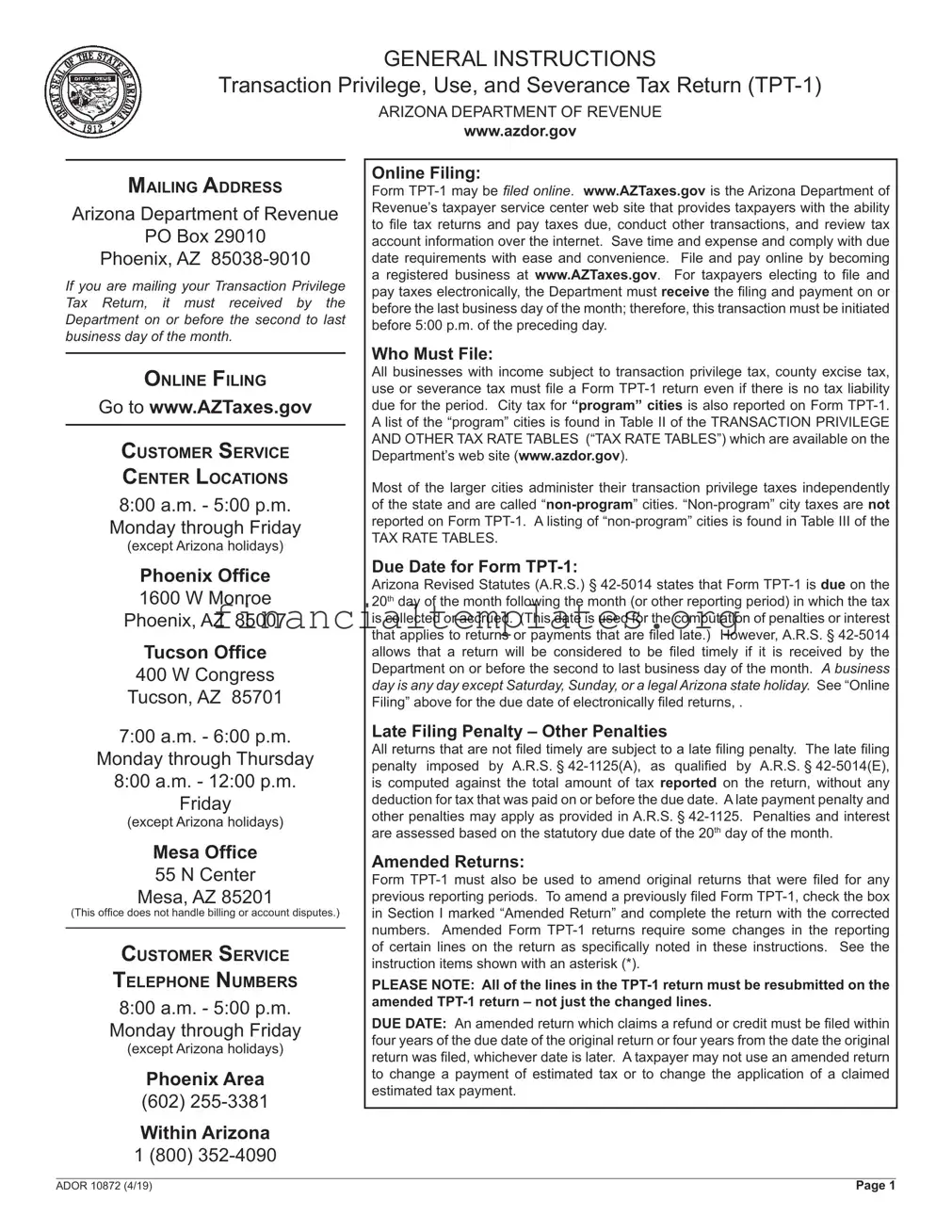Transaction Privilege, Use,
and Severance Tax Return (TPT-1)
|
TRANSACTION PRIVILEGE, USE, AND |
TPT-1 return is due the 20th day of the month following |
|
SEVERANCE TAX RETURN (TPT-1) |
the reporting period. |
|
STATE LICENSE NUMBER: |
|
Arizona Department of Revenue |
|
|
PO BOX 29010 • PHOENIX, AZ 85038-9010 |
|
TAXPAYER IDENTIFICATION NUMBER: |
|
|
|
|
FOR ASSISTANCE OUT-OF-STATE OR IN THE PHOENIX AREA: |
(602) 255-3381 OR |
|
|
|
|
EIN |
SSN |
|
|
|
|
|
STATEWIDE, TOLL FREE FROM AREA CODES 520 AND 928: (800) 352-4090 |
PERIOD BEGINNING: |
PERIOD ENDING: |
|
|
|
I. TAXPAYER INFORMATION |
|
M M D D Y Y Y Y |
M M D D |
Y |
Y |
Y |
Y |
Amended |
Multipage |
One-Time |
Final Return: DOR USE ONLY |
LABELED RETURN |
Return |
Return |
Only Return |
(CANCEL LICENSE) |
|
BUSINESS NAME |
|
|
|
|
|
|
|
|
|
|
|
|
|
C/O |
|
|
|
|
|
|
|
|
|
|
|
|
|
ADDRESS |
|
|
|
|
POSTMARK DATE |
|
|
|
|
|
|
|
|
CITY |
|
STATE ZIP |
|
|
|
|
|
|
|
|
|
|
|
|
|
|
|
|
RECEIVED DATE |
|
Address Changed
II. TRANSACTION DETAIL (If more reporting lines are necessary, please attach continuation pages.)
LINE |
|
(A) |
(B) |
(C) |
(D) |
(E) |
(F) |
|
|
(G) |
(H) |
(I) |
|
(J) = (F × I) |
|
BUSINESS |
REGION |
BUSINESS |
|
|
|
|
|
|
|
|
|
ACCOUNTING |
|
ACCOUNTING |
|
DESCRIPTION |
CODE |
CODE |
GROSS AMOUNT |
DEDUCTION AMOUNT |
NET TAXABLE AMOUNT |
TAX RATE |
TOTAL TAX AMOUNT |
CREDIT RATE |
|
CREDIT |
1 |
|
|
|
|
|
|
|
|
|
|
|
|
|
|
|
|
|
2 |
|
|
|
|
|
|
|
|
|
|
|
|
|
|
|
|
|
3 |
|
|
|
|
|
|
|
|
|
|
|
|
|
|
|
|
|
4 |
|
|
|
|
|
|
|
|
|
|
|
|
|
|
|
|
|
5 |
|
|
|
|
|
|
|
|
|
|
|
|
|
|
|
|
|
|
Subtotal |
|
|
|
|
|
|
|
|
|
|
|
|
|
|
|
III. TAX COMPUTATION |
|
|
|
|
|
|
|
|
|
|
|
|
|
|
|
|
Total deductions from Schedule A |
|
|
|
|
|
|
|
|
|
|
|
|
|
1 |
|
|
1 |
|
|
|
|
|
|
|
|
|
|
|
Total Tax Amount (from column H) |
|
|
|
|
|
|
|
|
|
|
|
|
|
2 |
|
|
2 |
|
|
|
|
|
|
|
|
|
|
3 |
State excess tax collected |
|
|
+ |
3 |
|
|
|
|
|
|
|
|
|
|
4 |
Other excess tax collected |
|
|
+ |
4 |
|
|
|
|
|
|
|
|
|
|
5 |
Total Tax Liability: Add lines 2, 3, and 4 |
|
= |
5 |
|
|
|
|
|
|
|
|
|
|
6 |
..............................................................Accounting Credit (from column J) |
|
|
6 |
|
|
|
|
|
|
|
|
|
|
7 |
State excess tax accounting credit: Multiply line 3 by .01 |
+ |
7 |
|
|
|
|
|
|
|
|
|
|
8 |
Total Accounting Credit: Add lines 6 and 7 |
|
= |
8 |
|
|
|
|
|
|
|
|
|
|
9 |
................................................Net tax due line: Subtract line 8 from line 5 |
|
|
9 |
|
|
|
|
|
|
|
|
|
|
10 |
Penalty and interest |
|
|
|
+ |
10 |
|
|
|
|
|
|
|
|
|
|
11 |
TPT estimated payments to be used |
|
- |
11 |
|
|
|
|
AMENDED RETURN ONLY |
|
|
|
|
|
|
|
|
|
|
|
|
|
ORIGINAL REMITTED AMOUNT |
|
|
12 |
Total amount due this period |
....................................................................... |
|
= |
12 |
|
|
|
|
$ |
|
|
|
|
|
13 |
Additional payment to be applied (for other periods) |
+ |
13 |
|
|
|
|
|
|
|
|
|
|
|
TOTAL AMOUNT REMITTED WITH THIS RETURN |
= |
|
|
|
|
|
$ |
DOR USE |
|
|
|
14 |
14 |
|
|
|
|
|
|
|
|
Under penalties of perjury, I declare that I have examined this return, including accompanying schedules and statements, and to the best of my knowledge and belief, it is true, correct and complete. Declaration of preparer (other than taxpayer) is based on all information of which preparer has any knowledge.
|
|
|
|
|
|
► |
|
|
|
|
|
|
|
|
|
PAID PREPARER’S SIGNATURE (OTHER THAN TAXPAYER) |
|
|
|
► |
|
|
|
|
|
|
|
|
|
|
|
TAXPAYER’S SIGNATURE |
DATE |
|
PAID PREPARER’S EIN OR SSN |
|
|
|
|
|
|
|
|
|
|
|
|
ADOR 10872 (2/16) |
Please make check payable to Arizona Department of Revenue. |
|
|
|
|
|
|
|
|
|
|
|
|
|
|
|
Transaction Privilege, Use, and Severance Tax Return (TPT-1) |
|
LICENSE NO. ______________________ |
|
|
Schedule A: Deduction Detail Information
The deduction amounts that have been listed on the lines in Section II, Column E must be itemized by category for each Region Code and Business Code reported. The total of the amounts listed in Schedule A must equal the total of the Deduction Amounts listed on page 1. (See page 4 of the TPT-1 Instructions.)
Deduction Codes for itemizing deductions, with a paraphrased description of the deduction (or exemption), are listed at www.azdor.gov. Some of the codes may be used for more than one business code. Several additional Deduction Codes, as well as the statutory wording and any administrative guidance for each deduction code, are provided on the Department’s web site. The actual text of the statutory deduction, exemption or exclusion is controlling for amounts taken as deductions on Form TPT-1. Schedule A must be completed and attached for deductions to be allowed. Unsubstantiated or incorrect deductions will be disallowed and penalties and interest will apply.
SCHEDULE A
Deduction Detail
|
LINE |
(K) |
(L) |
(M) |
(N) |
(O) |
|
DEDUCTION |
DEDUCTION |
DESCRIPTION OF |
|
REGION CODE |
BUSINESS CODE |
|
CODE |
AMOUNT |
DEDUCTION CODE |
|
|
|
|
1
2
3
4
5
6
7
8
9
10
11
12
13
14
15
16
17
18
19
20
21
22
23
A Subtotal of Deductions ..............................
B Deduction Totals from Additonal Page(s) ..
CTotal Deductions (line A + line B = line C)..
Total Must Equal Total on Page 1, Section III, line 1
ADOR 10872 (3/15)
INSTRUCTIONS
The following numbered instructions correspond to the numbered sections of the sample Form TPT‑1. An example of completing
Section II of Form TPT‑1 and Schedule A is provided on page 4. When completing this form, please print or type in black ink.
Section I – Taxpayer Information
1 *Business Name and Address
If you are preparing a blank form, write in the correct information. If you are completing a preprinted form, check the accuracy of the business name and mailing address printed on the form. Make corrections on the form as required. If you make changes to the address, check the “Address Changed” box. If the return is an *amended return, a multipage return, a one‑time only return, or if you are canceling your license and this is your final return, please check the appropriate
box.
2State License Number
If you are preparing a blank form, write in the correct number. If you are completing a preprinted form, check the accuracy of the Transaction Privilege Tax or Use Tax license number printed on the form. This number should include all eight (8) numerical digits. The state license number must also be placed in the top right hand corner
of all other pages of the return.
3Taxpayer Identification Number
In addition to the Transaction Privilege Tax License Number, a Taxpayer Identification Number is also required when filing any return. Check the accuracy of the Taxpayer Identification Number. The Taxpayer Identification Number is the number that the licensee uses to report federal income tax for the business: either the federal employer identification number (EIN) or social security number (SSN). Missing, incorrect or illegible Taxpayer Identification Numbers
may result in a penalty and will cause delays in processing the return.
4 Reporting Period
Check the accuracy of the PERIOD BEGINNING and the PERIOD ENDING boxes, and make corrections if necessary. If this
information is missing, write in the correct periods in an eight‑digit
format (MMDDYYYY). Taxpayers that have been authorized by the Department to file on a quarterly or annual basis must enter the first
and last months of the quarter or year in these periods.
Section II – Transaction Detail
*Note: For an amended return, complete Section II (and Schedule
A)with the corrected numbers. Include all lines that were present on the original return, even if there are no changes to some lines. See below for special instructions for certain lines in Section III Tax Computation.
For any return which requires more than five lines, use a continuation sheet to report the additional lines, and check the “multipage return” box in Section I.
5Business Code Description [Column A]
This column will identify your type of business, or “code.” For example, “retail,” “restaurant/bar,” “contracting,” etc. A list of business codes and other reporting categories, and the corresponding business code numbers, can be found in Table I of the TAX RATE TABLES.
When reporting “program” city tax on the TPT‑1, write the city name in this column. A list of “program” cities can be found in Table II of the
TAX RATE TABLES.
6Region Code [Column B]
This column identifies the county or city in which you conduct business, or the special region code required of some businesses. For counties or special regions, the region code will be three letters
(e.g., MAR for Maricopa County). For program cities, the region code
will be two letters (e.g., KM for Kingman). Please refer to the TAX RATE TABLES for the appropriate region codes. (See Tables II, IV,
or V.)




